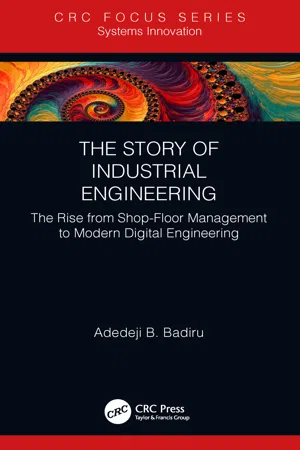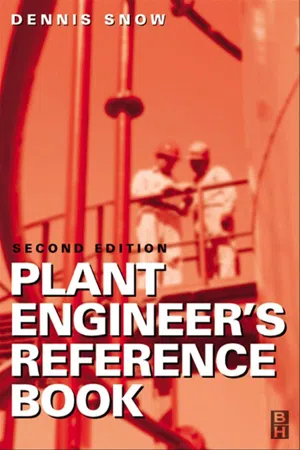Engineering Institution
An engineering institution is an organization that promotes and supports the field of engineering through education, research, and professional development. These institutions often provide accreditation for engineering programs, offer resources for engineers, and contribute to the advancement of engineering knowledge and practices. They play a crucial role in shaping the future of the engineering profession.
3 Key excerpts on "Engineering Institution"
- eBook - ePub
The Story of Industrial Engineering
The Rise from Shop-Floor Management to Modern Digital Engineering
- Adedeji B. Badiru(Author)
- 2018(Publication Date)
- CRC Press(Publisher)
...My conclusion is that the military directly and indirectly influenced the advancement of technical manpower in the United States. What the United States is enjoying today in terms of being a world leader is predicated on a foundation of consistent technical education over the years. For this reason, investment in industrial engineering education is essential not only to keep the military on the cutting edge of warfare technology, but also to positively impact the national landscape of education on a broad scale. Relevance to National Academy of Engineering’s 14 Grand Challenges Recognizing the urgent need to address global societal issues from a technical standpoint, in 2008, the National Academy of Engineering (NAE) published the “14 Grand Challenges for Engineering.” The challenges have global implications for everyone, not just the engineering professions. As such, solution strategies must embrace all disciplines. Industrial engineering, by virtue of its global presence and wider span of application in science, technology, engineering, and mathematics (STEM) education can provide the technical and human foundation for addressing many of the challenges. Industrial engineers of the future will need diverse skills to tackle the multitude of issues and factors involved in adequately and successfully addressing the challenges. Industrial engineers, in particular, are needed to provide the diverse array of technical expertise, discipline, and professionalism required...
- eBook - ePub
- Miriam E. David, Marilyn J. Amey(Authors)
- 2020(Publication Date)
- SAGE Publications Ltd(Publisher)
...A research university is a doctoral degree-granting institution known for specialized study and research activity among faculty and staff. Carnegie further categorizes doctoral institutions by the degree of research activity. Institutions also may have more specialized missions. Polytechnic institutions and institutes of technology focus on applied science, technology, and engineering. In Australia, technical and further education colleges provide vocational training to serve the regional communities similar to community colleges in the United States. Medical institutes, art and design schools, and private graduate and professional schools where the majority of students are in a common field of study are categorized by Carnegie as special focus institutions. Institutions may also be defined as faith-based institutions where the teachings of the faith are central to their mission and operations or as military institutions for their focus on training members of the military. Institutions are often categorized by their historically situated missions. In the United States, this includes historically Black colleges and universities, which often, but not always, predominantly serve Black students. In South Africa, historically disadvantaged institutions were designated for people of color during apartheid and continue to face disadvantages. In the United States, a tribal colleges and universities designation may be denoted to emphasize its focus on educating Native American communities and historical and cultural preservation. Additionally, a land-grant institution designation may be denoted to emphasize an institution’s public mission, focus on agriculture or engineering, or its history of receiving substantial federal financial support. Student Demographics Institutions are also categorized based on the demographics of the student body...
- eBook - ePub
- DENNIS A SNOW(Author)
- 2001(Publication Date)
- Butterworth-Heinemann(Publisher)
...Engineering was not considered suitable for those with the ability to enter a British university, where arts and sciences were studied. The need for education in engineering in the UK was met by the development of Mechanics Institutes. By the middle of the nineteenth century around 120 000 students per annum attended some 706 institutes on a part-time basis, thus laying the foundations for the pattern of engineering education in the UK. In 1840 the first chair in an engineering discipline (civil engineering) was established at Glasgow University, soon to be followed by one at University College, London. Oxford and Cambridge were late on the scene, establishing chairs in engineering in 1875 and 1910, respectively. Also peculiar to the UK is a somewhat confusing array of professional Engineering Institutions. These were originally learned societies where like-minded people met to exchange views and information. They developed into qualifying bodies by setting levels of experience and academic attainment for different grades of membership. The oldest professional Engineering Institution in the UK is the Institution of Civil Engineers, established in 1818. The Institution of Mechanical Engineers was established in 1847 and the Institution of Electrical Engineers in 1871. Three quarters of the approximately 35 institutions which are the Nominated Bodies of the Engineering Council were founded in the twentieth century, some quite recently, reflecting the growth of certain engineering disciplines such as nuclear engineering, computing and electronics. 46.2 The Institution of Plant Engineers The Institution of Plant Engineers (IPlantE) had its origins in the Second World War, when engineers who found themselves responsible for the operation and maintenance of the large excavators and other mobile plant brought from the USA to work open-cast coal met together for the exchange of information and to discuss their problems...


